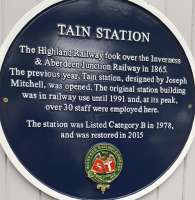This day in history 17 June
Images
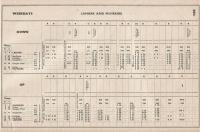
Inches: Extract from the Scottish Region working timetable Section B effective 17th June 1957. Poor services like this were a gift to bus companies with their cheaper fares, something you will read time and again in contemporary accounts. I wonder how long that 13 minutes at Inches felt when you were in a hurry to get home?

Possil: Possil station.
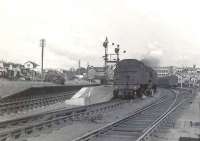
Possil: Motherwell based Fairburn tank 42200 with a train in the bay at Possil in June 1958.
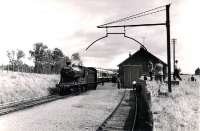
Strathmiglo: NBR256 westbound at Strathmiglo with the 1960 RCTS/SLS Joint Scottish Tour.

Kincardine: NBR 256 pauses at Kincardine while heading west with the 1960 RCTS/SLS Joint Scottish Tour.

Gateside: NBR 256 at Gateside with the westbound 1960 RCTS/SLS Joint Scottish Tour.
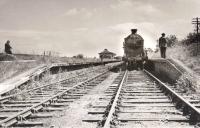
Cairneyhill: The SLS/RCTS 'Joint Scottish Tour' at Cairneyhill on 17 June 1960 behind NBR 256 Glen Douglas.
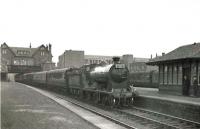
Possil: Admiring glances on the platform at Possil station on 17 June 1960 as NBR 256 Glen Douglas makes a photostop with the SLS/RCTS 'Scottish Rail Tour'. The 6-day tour, which had started from Edinburgh Waverley on 12 June, would end at Glasgow Central just over half an hour after this stop. A total of 11 steam locomotives were used during the tour, tickets for which cost £14.

Denny: NBR 256 at Denny with the 1960 RCTS/SLS Joint Scottish Tour. View looks west.
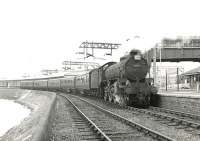
Craigendoran Pier: B1 61029 Chamois alongside the Clyde at Craigendoran Pier on 17 June 1961 with a military special for Barry Camp. See image [[50603]]

Newcastle Central: Scene at the east end of Newcastle Central in the summer of 1961. The steam locomotive is A2 Pacific no 60514 Chamossaire. Beyond stands one of the South Tyneside electric units, displaying the legend 'South Shields - Stopping'. The South Shields route was converted to DMU operation two years later and now forms part of the Tyne and Wear Metro.
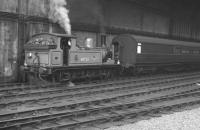
Newcastle Central: One of Gateshead shed's class J72 0-6-0Ts no 68723, specially repainted for station pilot duties at Newcastle Central, shunts a TPO in the station on 17 June 1961.

Newcastle Central: Summer Saturday 9.2am ex-Ely runs into Newcastle Central on 17 June 1961 having arrived via the High Level Bridge. Locomotive in charge is A3 Pacific no 60088 Book Law.
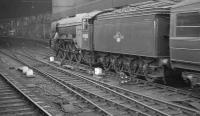
Newcastle Central: The 9.02am summer Saturday Ely - Newcastle Central arrives at its destination on 17 June 1961 behind A3 Pacific 60088 Book Law. The train has been routed via King Edward Bridge East Junction and the High Level Bridge.
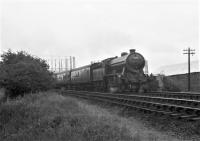
Westerton: A less than ideal photographic location, a dull wet afternoon and a flawed negative, but this was billed at the time as the final occasion on which a K2 would head for the West Highland line. On 17th June 1961, Eastfield turned out 61764 'Loch Arkaig' for the 2.50pm Saturdays-only from Glasgow Queen St to Crianlarich, seen here passing Temple, between Maryhill and Westerton. 'Loch Arkaig' was the last surviving K2 and remained active around Glasgow for another couple of months, but as far as I know never ventured again to its West Highland line home patch.
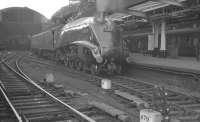
Newcastle Central: A4 Pacific no 60022 Mallard photographed following arrival at Newcastle Central on 17 June 1961 with the 10.00 London Kings Cross - Edinburgh Waverley.
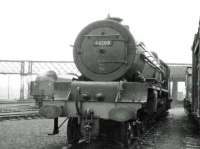
Carlisle Upperby Shed: Stanier pacific 46200 The Princess Royal stored awaiting disposal in the sidings alongside Upperby shed in June 1964. The locomotive was cut up in the Calder scrapyard of Messrs Connell & Co at Coatbridge, some four months later.
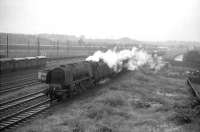
Carlisle Upperby Shed: Stanier Pacific no 46228 Duchess of Rutland passes Carlisle Upperby with a down parcels train on a wet Wednesday in June 1964.
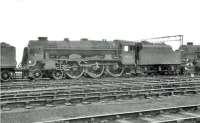
Carlisle Kingmoor Shed: Rebuilt Royal Scot 46162 Queen's Westminster Rifleman photographed in the shed yard at Carlisle Kingmoor on 17 June 1964, a little over two weeks after official withdrawal.
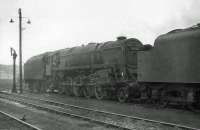
Carlisle Kingmoor Shed: BR Standard class 9F 2-10-0 no 92120 stands in the yard at Carlisle Kingmoor shed on a grey and overcast 17 June 1964.
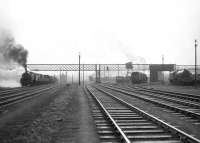
Carlisle Upperby Shed: Edge Hill based Crab 2-6-0 42920 brings a southbound freight past Upperby shed on 17 June 1964. Standing alone on the far right awaiting disposal is Stanier Pacific 46200 The Princess Royal see image [[52671]].
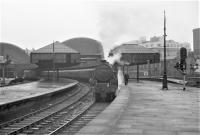
Glasgow St Enoch: Black 5 44677, seen on 17th June 1966, preparing to leave Glasgow St Enoch with the 4.45pm parcels for Carlisle. Although the train looks quite lengthy, the service often left the station with only one van, and may indeed have done so on this occasion. I believe it was effectively a pick-up, with other parcels vans and postal coaches being collected en route south.
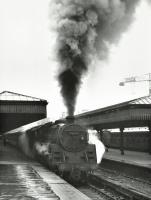
Buchanan Street: On a wet evening at Glasgow Buchanan Street in June 1966, Standard Caprotti 5MT 4-6-0 73149 slips as it starts the 5.35pm service to Dunblane. *17/6/66*
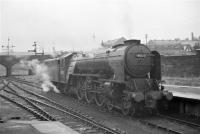
Buchanan Street: A2 Pacific 60532 'Blue Peter' awaiting clearance to reverse out of Glasgow Buchanan St after bringing in the 5.30pm arrival from Aberdeen on 17th June 1966.
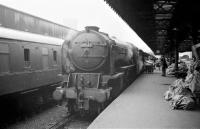
Buchanan Street: A2 Pacific 60532 'Blue Peter' at Glasgow Buchanan St on 17th June 1966. The buffer beam reflects the locomotive’s long-standing association with Dundee Tay Bridge, but 61B on the smokebox affirms the recent move to Aberdeen’s Ferryhill, which made regular use of the engine on the 1.30 pm to Glasgow and 11.30 pm return during the final few months of steam haulage on the route.

West Hampstead Thameslink: The Midland main line 3 miles out of St Pancras in June 1969. A 'Peak' is about to take a semi-fast for Nottingham under the bridge carrying West End Lane. The station on the other side of the bridge was named 'West Hampstead Midland' at that time, one of the six names it carried following its opening in 1871. In 1988 it was renamed 'West Hampstead Thameslink'. Within 200 yards of here, on the same street, are two other stations, one serving the Jubilee Line - called West Hampstead, the other serving the North London Line, this one called.... West Hampstead.
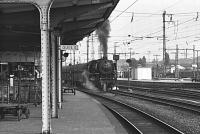
Rheine: View from the platform of Rheine station in the summer of 1976 as DB 043-196-5 sets off for Emden with a freight.

Salzbergen: A class 043 heads north under the wires at Salzbergen in the summer of 1976.
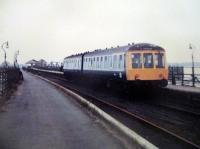
New Holland Pier: A rather grainy image of a Derby DMU, heading away from the camera, running 'wrong line' as it approaches New Holland Pier station on 17th June 1981. Services along the pier ceased one week later, concurrently with the opening of the Humber Bridge and the end of the ferries to Hull.

New Holland Pier: British Railways Eastern Region running-in board at New Holland Pier on 17th June 1981, one week before closure and the end of the Humber ferries with the opening of the road bridge. I was glad to have the chance to cross the river by ferry, my first and last time to do so.
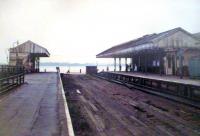
New Holland Pier: Dying days at the near derelict New Holland Pier station, on 17th June 1981. It closed one week later with the end of the ferries across the Humber Estuary to Hull, concurrently with the opening of the Humber Bridge.
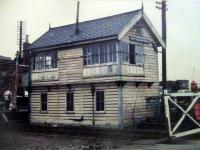
New Holland Town: New Holland Town signal box on 17th June 1981, one week before the end of services along New Holland Pier and withdrawal of the ferries across the Humber estuary to Hull on 24th June, superseded by the opening of the then new Humber Bridge. Fortunately I was able to enjoy a ferry trip just before they ceased.
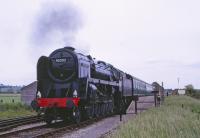
Cranmore: BR 9F 2-10-0 92203 'Black Prince' working a passenger train on the East Somerset Railway on 17 June 1985. From the notes, Major Oliver from the Railway Inspectorate was present and probably carrying out an inspection of the ESR.
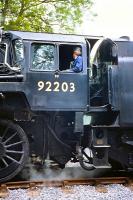
Cranmore: Cabside view of BR Standard class 9F 2-10-0 no 92203 at Cranmore on the East Somerset Railway on 17 June 1985.

Slateford: BR Coal Sector liveried 60074 Braeriach with an eastbound coal train crossing over to run 'wrong line' through Slateford station in 1993 in order to access Slateford Junction. From here it will take the 1961 west to south curve to Craiglockhart Junction where it will join the 'sub'. See image [[10257]]
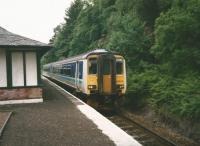
Arrochar and Tarbet: An Oban service calls at Arrochar in June 1998. By today's standards the ScotRail branding on the 156 is rather understated. The colours of the 'swoosh' were tried out as a livery (see image [[20986]]) but never adopted.
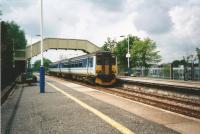
Bishopbriggs: A Class 156 from Queen Street to Falkirk Grahamston calls at Bishopbriggs in June 1997. Around this time there was a crush-relieving service from Queen Street to Bishopbriggs only; this was both ScotRail's sole non-stop service and its shortest.
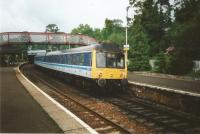
Aberdour: In the late 1990s Haymarket shed held on to a few first generation DMUs to meet demand at peak times. On 17 June 1997 a Class 117 is seen at Aberdour on a Fife Inner Circle working.

Portobello Junction: A train to North Berwick passing Portobello in June 2004. The locomotive propelling the train is EWS 90026.

Portobello Junction: A class 90 hauled train from North Berwick passing Portobello Junction on 17 June 2004 on its way to Waverley, with a DVT bringing up the rear.
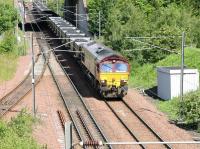
Newcraighall Junction: A loaded coal train from Ravenstruther enters the north end of Millerhill Yard on 17 June 2005 behind EWS 66048. The coal is destined for Drax power station, North Yorkshire.

Shields Depot: A Class 314 stabled at Shields Depot.
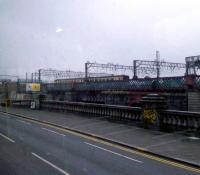
Clyde Viaduct [Glasgow Central]: A Class 156 departs Glasgow Central across the Clyde Viaduct. The supports for the old viaduct are in the forground. Taken from Glasgow Bridge.
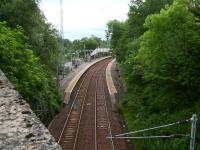
Patterton: A quiet Sunday morning in June 2007 at Patterton station, looking east from the B769 roadbridge towards Whitecraigs.

Dunlop: View south over Dunlop station from the roadbridge on 17 June 2007.
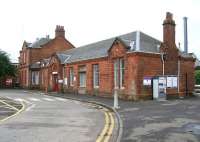
Johnstone: The classic 1840 station building at Johnstone, photographed on 17 June 2007 from the station car park looking east towards Glasgow. See image [[15623]]

Dalry: A southbound service draws to a stop at Dalry in June 2007.

Howwood: The basic facilities at Howwood on 17 June 2007. The station opened in March 2001 and is located south west of the original station which had been closed in 1955.

Lochwinnoch: View south from the A760 road bridge at Lochwinnoch on 17 June 2007. See image [[34507]]).

Johnstone: The station building at Johnstone, Renfrewshire, on a Sunday morning in June 2007. View is north east towards Paisley and Glasgow Central.

Stewarton: The 1871 station at Stewarton in June 2007, looking north towards Dunlop.

Glengarnock: View south west over Glengarnock station towards Dalry on 17 June 2007. Originally opened as Glengarnock and Kilbirnie in 1840, it became plain Glengarnock in 1905.

Magdalen Green: Much to crow about. Four wheel carriage of antiquity? Found in the carpark opposite Magdalen Green on Riverside Drive Dundee.

Stewarton Viaduct: Shortly after leaving Stewarton station southbound the G&K Joint line crossed the tall 1868 Annick Water Viaduct. Photograph taken on 17 June 2007 looking east showing part of the listed 10-arch structure spanning the A735 with the valley of the Annick Water off to the right.
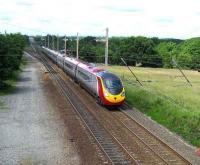
Balshaw Lane Junction: Pendolino at speed southbound at Balshaw Lane Junction on 17 June 2007.
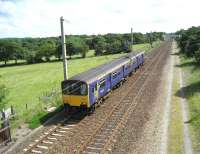
Balshaw Lane Junction: A Northern service from Blackpool North to Liverpool Lime Street heads south from Balshaw Lane Junction towards the next scheduled stop at Wigan on 17 June 2007.

Priesthill and Darnley: Platform view west at Priesthill and Darnley on 17 June 2007.

Milliken Park: A Sunday morning PW train, with EWS 66016 bringing up the rear, heads north east towards Johnstone on 17 June 2007. The train has just passed below Cochranemill Road bridge, with Milliken Park station directly behind the camera.

Stewarton Viaduct: The impressive 10 arch Annick Water Viaduct (1868) to the south of Stewarton station. Photographed in June 2007 looking south west along the A735.

Kennishead: View north east from Kennishead station footbridge on 17 June 2007.

Magdalen Green: View north near the former site of Magdalen Green station, with the ever present bandstand looking on.

Tay Bridge: 1240 Edinburgh to Aberdeen rounds the curve off the Tay Bridge into Dundee. Work is well underway to exchange the deck bearings and trusses, etc. The train is made up of two different class 170 liveries. The first three coaches are in dark blue Firstscotrail colours and the second set of three carriages are painted in the promotional livery promoting the 2014 Commonwealth Games in Glasgow, which was successful.

Kilmaurs: The 1984 station at Kilmaurs, looking south in June 2007. The original 1873 station had closed in November 1966.
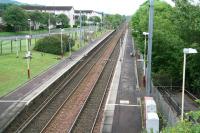
Milliken Park: View west over Milliken Park station, Renfrewshire, on 17 June 2007.

Tay Bridge: Riverside Drive is busy in June 2007 as this 6 car 170 slows for the ninety degree turn towards Dundee station.

Bathgate [4th]: Gone - and largely forgotten? The old station at Bathgate, which closed in October 2010, was handier for the town centre (it could hardly have been closer) but it was not well appointed. The new station is a big improvement. 170 453 stands at the old one on 17 June 2008, having just arrived from Edinburgh.

Berwick-upon-Tweed: An Edinburgh-bound CrossCountry service pulls into Berwick on 17 June 2009.
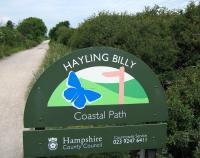
Hayling Island: Hayling Billy railway coastal path sign. The path serves walkers, cyclists and horse riders.
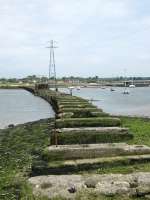
Hayling Island: The piers are all that is left of the Hayling Island timber railway bridge. Weight restrictions on the bridge meant the line was worked by tiny A1X class tank engines, nicknamed Terriers, which were originally designed for South London suburban services. The line was closed by BR in 1963.

Berwick-upon-Tweed: Berwick-upon-Tweed - a history lesson above the stairs down to the platforms. Watch your step...

Hayling Island: Site of Hayling North Halt which was principally a timber platform.

Hayling Island: Remains of signal post on Hayling Island at South end of bridge to mainland.

Hairmyres: Glasgow bound 156 505 departs from Hairmyres on 17 June 2009. The offices of the East Kilbride World [newspaper] are housed within the smaller of the two white buildings in the background, the second and larger being apartments. Part of Hairmyres Hospital ambulance depot can be seen on the extreme right.

Hayling Island: Graphic from Railway Junction Diagram book showing Hayling Billy Railway.

Berwick-upon-Tweed: The Up platform and (left) booking hall at Berwick on 17 June 2009.

Reading: The 1827 CrossCountry service from Manchester to Bournemouth about to depart from Reading on 17 June 2009.
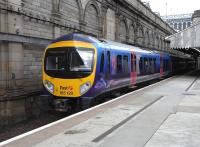
Edinburgh Waverley: 185 129 pulls out of Waverley sub platform 8 with a First TransPennine Express service for Manchester Airport on 17 June 2009.

Reading: First Great Western 166202 waits in eastbound bay platform 6 at Reading on 17 June 2009 forming the 2215 hrs stopping service to Paddington.

Berwick-upon-Tweed: View north along the Up platform at Berwick on 17 June 2009

Berwick-upon-Tweed: LNER monogrammed canopy supports outside the booking hall at Berwick, surprisingly ornate considering the period.
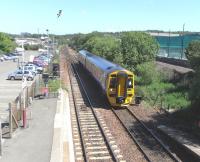
Cumbernauld: Complete with seagull escort, unit 158 729 approaches Cumbernauld on 17 June 2010 with a Falkirk Grahamston - Glasgow Queen Street service.

Larbert: While Larbert Junction has been controlled by LED MAS from Larbert North for 3 three years now the vicinity of Larbert North box itself is still semaphore territory. This MAS on the Down Line looks as if it has been felled and is being claimed by nature, but as far as I know it has never been upright. The semaphore it should replace is certainly still in service. The LED repeater before the triple overbridge at Larbert station is in place (and vertical) though covered up.

Greenfaulds: 156 435, today's set for the Cumbernauld to Motherwell service, calls at Greenfaulds on 17 June 2010.
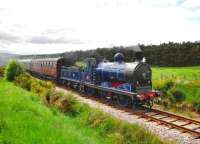
Broomhill: I'm Back! Immaculate Caledonian 0-6-0 no 828 looks in fine fettle following its £220,000 major overhaul as it heads the last train of the day mid-way between Boat of Garten and Broomhill on 17 June 2010. [See recent news item]

Whifflet South Junction: Services terminating at Whifflet have to clear the through line by first running forward then retreating into the Sunnyside Goods line, which is alongside and almost parallel with Whifflet station, before returning to Glasgow. This means three changes of ends per visit, as with Cowdenbeath. On 17 June 156 512 emerges back on to the Up Coatbridge line where it will cross over to the Down line, then reverse for the third and final time for the return to Glasgow.
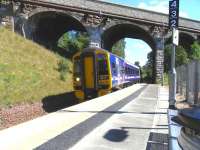
Kelvindale: 'Dawsholm' - or so the 2005 station at Kelvindale was originally to be named. The change of mind must have happened rather late in the process; either that or someone just forgot to tell Ordnance Survey, as the current 1:25,000 map calls it 'Dawsholm Sta'. On 17 June 158730 pulls in with a service for Anniesland, from where I'd just walked in a few minutes - typically for this line.
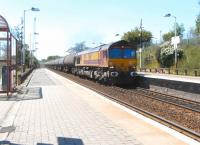
Greenfaulds: 66 111 heads north through Greenfaulds station with an oil train on 17 June 2010.

Totnes: The old Great Western signal box at Totnes has been put to good use as the station buffet, accessed from the footbridge. The lever frame has been removed of course but the view from the tables is just the same as that enjoyed by the signalmen in operational days. Alongside the signalbox is Brunel's old Atmospheric Railway engine house, which was never used for its original purpose because the atmospheric system was abandoned after serious problems around Dawlish and Starcross.

Larbert: View north at Larbert on 17 June, as 158 722 pulls in with a Dunblane to Edinburgh service.

Totnes: A Penzance to Edinburgh service, formed by a Cross Country Super Voyager, calls at Totnes in this view westwards from the station footbridge. There are still two through roads at Totnes, in addition to the two platform lines, allowing overtaking between Plymouth and Newton Abbott and also giving freights a run at the steep banks that lie either side of the station.
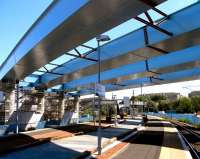
Rutherglen: Works in connection with the M74 extension cast lengthy shadows over Rutherglen station on 17 June 2010. Platform view looking south east.
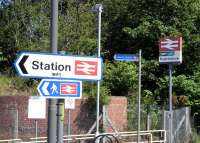
Kelvindale: The BR double arrow was apparently the most recognised logo in Britain. Because of the strong association with BR it must have come as a surprise to many, as it did me, that it would survive into privatisation as the generic symbol for the network. This little collection, photographed outside Kelvindale station on 17 June, seems to be a celebration of the double arrow, showing four ways of saying the same thing.
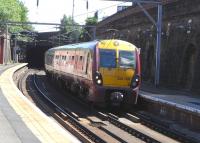
Bridgeton: 334 001 Donald Dewar passes through Bridgeton on a warm 17 June with a Larkhall to Dalmuir service. It is passing at no great speed, fooling people on the platform into thinking that it's a stopping service then, when it's clear that it's not going to stop, obliging them to pretend to each other that they knew this all along. For the reopening of the former Bridgeton Cross station in 1979 it was presumably thought a good idea to spell out 'Bridgeton' between double arrows in individually framed letters, but they are simply too far apart for it to be effective.
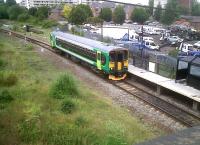
Bedford St Johns (New): A view from the road above of the 'new' St Johns station on the Bedford to Bletchley line. The vehicle recovery yard on the right contains four Standard cars - probably one of the largest collections anywhere! The train is the 15.55 from Bedford Midland to Bletchley. See image [[22133]]

Lowestoft: The heavily-rationalised interior of Lowestoft (Central, as was) station is not a place to fill one with confidence that we are living in the age of the train, but the external façade provides a delightful surprise, as this 17th June 2011 shot demonstrates. Is this the oldest extant station name sign on any British station?

Bedford: Looking South along the trackbed of the MR from Bedford to Hitchin - now serving as a car park for an engineering factory. A 153 can be seen heading for Bletchley, at a point where there used to be a flat crossing between these two lines. Sadly, there was a fatal collision here in Victorian times. see image [[34689]]

Bedford: Strange and unexpected (but very welcome) goings-on in Bedford. These sidings in front of the old warehouses adjacent to the Hitchin line (see image 30471) are being thoroughly refurbished, and that brick building going up on the left would have been a signal box in days gone by. Probably a signing on point and sidings for Thameslink - even though they will need a reversal to reach Midland station, and preferably some wires overhead. Good job they didn't sell off the land years ago!
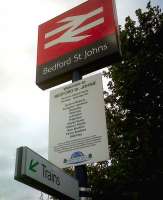
Bedford St Johns (New): Let's face it, we enthusiasts are too picky sometimes. Notice the order of stations on this sign: we might point out, perfectly accurately, that Bedford Midland is one way, and Kempston Hardwick the other. But locals just get on at St Johns, and ride out the reverse. You can't blame them - St Johns is, err, a bit 'functional'. Nice sign though.
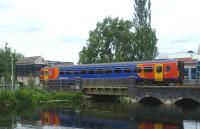
Lincoln: An East Midlands train leaving Lincoln on 17 June passing the disused East Holmes signal box.

Lostock Hall: The Preston Docks to Lindsey Oil Terminal empty bitumen tank train climbing from the WCML at Farington Curve Junction and approaching Lostock Hall on 17 June 2011. The Preston skyline can be seen at the top right of the photograph amongst the trees. The sight of Class 60 no 60024 on this working was a pleasant change from the usual Class 66.

Lincoln: Northern unit 153352 on Brayford level crossing just after leaving Lincoln station on 17 June 2011.

Holt: A West German built railbus waits to form the last departure of the day from the re-built Holt station on the North Norfolk Railway on 17th June 2011. For a unit built well over 50 years ago, I can vouch for the fact that it is surprisingly nippy. And great views to front and rear of course.
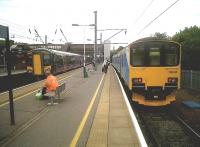
Bedford: Faced with a choice of exotic destinations on 17 June 2011 - Ashford for France on the left, Bletchley for Milton Keynes on the right. I opted for Bletchley, of course.

Cressbrook Tunnel: Walking west along the Monsal Trail in Derbyshire in June 2012. The trackbed is the former Midland Railway route from Derby to Manchester, here about to enter Cressbrook Tunnel, just west of the former Monsal Dale station.
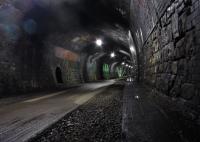
Cressbrook Tunnel: Inside Cressbrook Tunnel looking east on 17 June 2012 showing the lighting and the cycle/footpath. The tunnel is 471 yards long and on the right a 10' thick concrete slab runs the length of the tunnel and is believed to contain a water main.
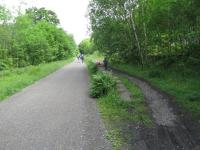
Monsal Dale: Looking east at the site of Monsal Dale station (closed to regular passenger service in 1959) in June 2012. The former down platform edge flagstones are still present as is a goods loading bank in the bushes on the right. The former up platform was constructed in wood and has long been removed. The double track main line has been replaced with the tarmac surface of the Monsal Way cycleway, footpath and bridleway.

Monsal Dale Viaduct: Looking west into Monsal Dale on 17 June 2012 with the former Midland Railway viaduct crossing the River Wye in the centre. To the left the railway entered Headstone Tunnel while in the middle distance it passed through Monsal Dale station before entering first Cressbrook and then Litton Tunnels. Today over 8 miles of the former railway trackbed (including 6 tunnels) have been converted into a footpath for walkers, cyclists and horse riders
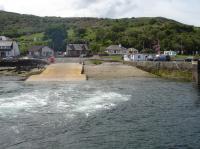
Lochranza Pier: A view of Lochranza slipway on Arran, from the Calmac Ferry MV Loch Riddon as it starts its 30 minute journey across the Kilbrannan Sound to Claonaig on Kintyre. 17th June 2013.
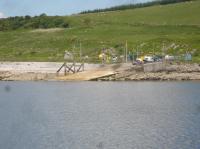
Claonaig Slip: A view of Claonaig slipway, on the Kintyre peninsula, taken from the Calmac Ferry MV Loch Riddon as it nears the end of its journey across the Kibrannan Sound from Lochranza on the Isle of Arran. 17th June 2013.
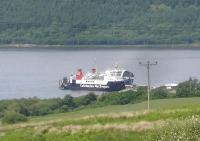
Kennacraig: View taken shortly before reaching the A83 road from Campbeltown to Tarbet, after leaving the Arran ferry from Lochranza at Claonaig Pier in June 2013. This is MV Hebridean Isles during its one hour mid-day layover at Kennacraig Pier, between sailings to Islay. The ship had arrived from Port Ellen and on departure will head for Port Askaig.
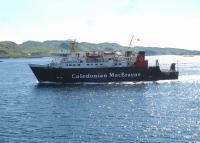
Oban Bay: CalMac's MV Lord of the Isles heads into Oban port passing MV Isle of Mull, which is heading out on the 16.00 sailing to Craignure port on Mull on 17 June 2013.
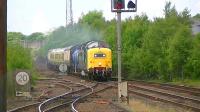
Kilmarnock: Juniper EMU 334003 arrives at Kilmarnock for refurbishment at Brodie Rail Works on 17 June behind D9000 Royal Scots Grey.
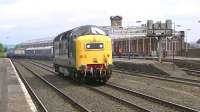
Kilmarnock: Deltic D9000 Royal Scots Grey running round Juniper 334030 at Kilmarnock station on 17 June following the EMU's refurbishment at at the nearby Brodie Rail Works.

Oban: View south from Albany Street on 17 June 2013, showing the Oban approach lines. The main line is to the left, with the former goods and carriage sidings on the right (now used for charter train refuge). Far right is a walkway installed by Network Rail for use by crews to lock the lever frame when an outward bound charter departs from platform 4. [With thanks to Doug Carmichael]
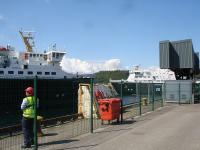
Oban Station Pier: CalMac Ferries MV Isle of Mull comes into the Mull berth at Oban on 17 June 2013, just as sister MV Clansman turns away from its mooring with the 15.40 sailing to Castlebay.

Lochranza Pier: CalMac Ferry MV Loch Riddon approaches Lochranza slipway on Arran to form the 12.00 return crossing to Claonaig terminal on Kintyre on 17 June 2013

Lochranza Pier: Builders Plate on CalMac ferry MV Loch Riddon, seen on the crossing from Lochranza on Arran to Claonaig on Kintyre, showing it to be boat H954 constructed, in 1986, at Dunston's Hessle shipyard on the north bank of the Humber Estuary in East Yorkshire. The previous boat built in the yard was sister CalMac ferry MV Loch Linnhe, whose builders plate shows it as boat H953. A total of four ferries were built for CalMac that year. The Yard ceased shipbuilding in 1994
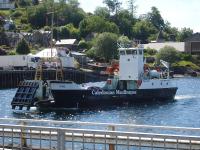
Oban Station Pier: Calmac Ferries 'MV Eigg' prepares to disembark its consist of cars and foot passengers as it runs into its berth at Oban following the crossing from Lismore on 17 June 2013. This was one of the smallest Calmac boats in service at the time.

Oban: 156485 photographed from the ferry terminal vehicle pre-loading waiting area as it runs into Oban with the slightly late running 15.28 arrival (12.21 ex Glasgow Queen Street) that links with the 16.00 Mull ferry. The two sidings and the former oil off-loading lines have seen little use for some time.
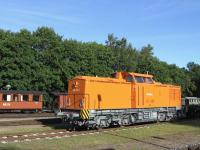
Putbus: Contrast at Putbus on 17th June - a standard-gauge diesel working for the Pressnitztalbahn company rests in Putbus station yard, while narrow-gauge stock of the Ruegensche Baederbahn (featuring delightful open platforms at each end of the coaches) stands in the background.
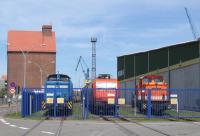
Stralsund Harbour: Pressnitztalbahn and Arcelor locos (left and middle respectively) on aggregates trains beside a shunting loco on the Stralsund harbour branch in Mecklenburg-Vorpommern (north east Germany) on 17th June. Note the electric loco on a non-electrified branch.

Irvine: The next train from Irvine is for ... er ... North Berwick??
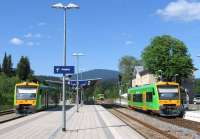
Zwiesel: An interesting network of branch lines radiates northwards from Plattling on the Passau-Regensburg main line, now operated on a franchise basis by the private Waldbahn company. The heart of this network in the Bayerischer Wald (Bavarian Forest) is at Zwiesel - seen here on 17th June - where branches radiate to Bodenmais and Grafenau, the main spine continuing north to the Czech border at Bayerisch Eisenstein, then onwards to Pilsen (as in the beer).

Cotehill: The Fellsman, shortly after leaving Carlisle on the Settle line on 17 June 2015. Photographed approaching Cotehill behind Jubilee 45690 Leander.
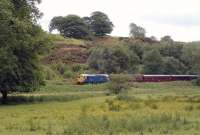
Cheddleton: A dining train hauled by 33102 approaching Cheddleton from Consall on 17 June 2015.
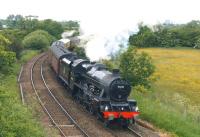
Farington Curve Junction: Jubilee no. 45690 Leander climbs the bank from Farington Curve Jct with The Fellsman railtour from Lancaster to Carlisle on 17 June 2015. The locomotive is working hard as it approaches Coote Lane road bridge with 11 coaches and a Class 47 on the rear.
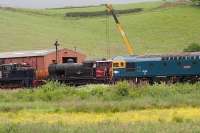
Cheddleton: BRCW 33102 about to take a train past stock undergoing maintenance at Cheddleton on the heritage Churnet Valley Railway on 17 June 2015.

Hoghton: Jubilee 45690 Leander approaching Hoghton with 'The Fellsman' on 17 June 2015 during the return trip from Carlisle.
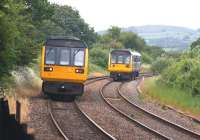
Hoghton: Blackpool South to Colne meets Colne to Blackpool South once again, this time on 17 June 2015 near Hoghton as 142038 on the left heads east passing 142053.
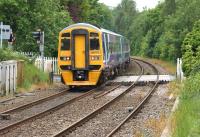
Hoghton: Northern 158752 crosses Hoghton level crossing heading west on 17 June 2015 with a York - Blackpool service.
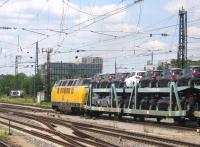
Regensburg: Regensburg on the Passau-Nuremberg main line in south east Bavaria sees a steady succession of national and international freight trains, operated by a wide range of rail hauliers. Here a lengthy car train pulls away after a short halt at Regensburg Hauptbahnhof on 17th June, hauled by vintage ex-Deutsche Bahn motive power in the shape of Class 221 106-8 of the Potsdam-based EGP company. The Class 221 - reminiscent of the British 'Warship' design - is a post-1962 derivative of the 1950s' Class 220 (originally V200.0), DB's first series-production diesel-hydraulic express loco [with thanks to Bill Jamieson].
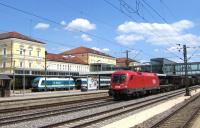
Regensburg : A typical scene at Regensburg in south east Bavaria on 17th June, with an international freight train - in this case hauled by an Austrian Railways (OBB) Taurus electric loco - hurrying through the centre roads at the Hauptbahnhof, while in the background a Class 223 diesel of the 'Alex' company has just been released from the stock of its Munich-Regensburg train. Alex also run the Munich-Prague trains, one of many franchised services which DB has lost to private operators in this part of Germany in recent years [with thanks to Bill Jamieson].
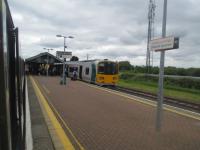
Limerick Junction: Limerick Junction, with Iarnrod Eireann 01 28050 waiting to depart for Limerick on right, seen from Kent Station Cork to Dublin Heuston train, behind Iarnrod Eireann 4007, looking back south, on 17th June 2016.

Milngavie: Milngavie Station at the Tropical entrance.
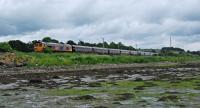
Cardross: 66733 approaches Cardross from the east with the Royal Scotsman. 66746 is out of sight on the rear.
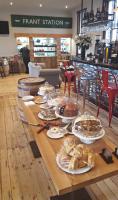
Tain: The interior of the Platform 1864 restaurant at Tain station (not Frant!).
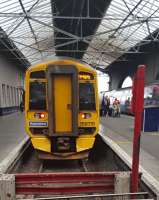
Inverness: An Ardgay bound commuter train leaves Inverness.
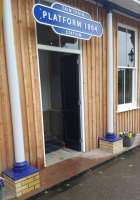
Tain: The main station building at Tain has been converted into a restaurant and some alterations made to the platform entrance, seen here.
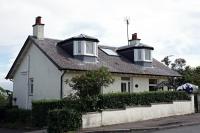
Dunure: The former house of the stationmaster at Dunure, confusingly at Fisherton. The station was also here, a fair distance from and height above Dunure. The trackbed nowadays is just a jungle and completely inaccesible. Under it all is the island platform - totally lost amongst the trees and shrubs. Photograph taken on 17 June 2016 showing what is now 'Station House'.

Heald Green: The nicely numbered 323232 pauses at Heald Green on the Styal Loop with a Crewe to Manchester Piccadilly (via the Airport) stopping service. Overhead an Easyjet Airbus has wheels down on final approach to Manchester.

Glasgow Queen Street High Level: Some excavations taking place in this scene showing the easternmost side. This may be connected to the need to improve drainage from Cowlairs Incline and Queen Street tunnel.

Manchester Airport: Future proofing? The Manchester Airport tram link was originally envisaged as a loop line from Wythenshawe. The line as opened is a long branch and the rest of the loop isn't in current construction plans but, as this picture of the tram platforms at the airport shows, the line could easily be extended in the future.
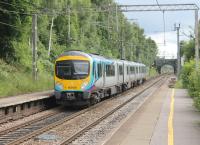
Heald Green: Sporting the revised livery that will be applied to the new trains on order for Trans-Pennine, 185108 passes through Heald Green on 17th June 2016. The train is signalled for the sharp right turn onto the Airport branch, just beyond the bridge.

Heald Green: A view from the entrance to the Down platform at Heald Green as 319363, in the then current 'Northern Electrics' purple livery, slows to call on 17th June 2016.
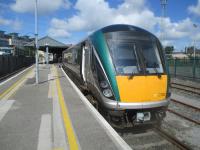
Tralee Casement: Iarnrod Eireann 02 22322 at Tralee station, County Kerry, waiting to depart for Mallow on 17th June 2016. This is the train my friend John (who lives in Tralee) and I boarded for Mallow, changing there for Dublin where we were spending the weekend.
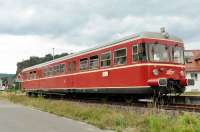
Dahn Süd: AVG Railcar VT452 at Dahn Süd with a service from Bundenthal-Rumbach, the terminus of the Wieslauterbahn, to Karlsruhe Hauptbahnhof. The railcar was built by Maschinenfabrik Esslingen in 1958 for the Deutsche Eisenbahn-Betriebs-Gesellschaft (DEBG). The AVG (Albtal Verkehrs Gesellschaft - a railway company owned by the city of Karlsruhe) acquired it in 1994 along with the Kraichtal and Katzbachtal lines (Ubstadt to Menzingen and Bruchsal to Odenheim respectively). It remained in regular service until 2000 and was restored to its original condition in 2009/10. When we first visited Dahn, in 1992, there were no passenger services on the Wieslauterbahn. Regular services were re-introduced in 1997, but only on Sundays and public holidays. Since then this has increased to include Saturdays and Wednesdays. [With thanks to Bill Jamieson for loco information.]
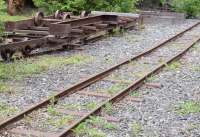
Skyttorp: An example of Decauville track on the ground at Skyttorps Maskinmuseum in Central Sweden. Consisting of portable sections of rails with bolted-on sheet metal sleepers, this can be laid directly on most types of ground surface including peat bogs without the need for a formation (track bed) or even ballast. Here the ballast is provided by locally occurring crushed rock. For more typical surface conditions see image [[59809]]. This system provides a quick and easy method of laying 600mm narrow gauge track for light rail in 'short term' use. It was used extensively on the trench railways of the Western Front during the Great War.
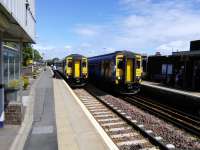
Barrhead: Full house at Barrhead with a stopping train for Glasgow in the bay, a non-stopper at Platform 2 and a Kilmarnock service pulling in to Platform 1.
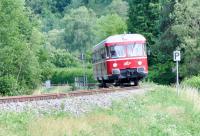
Dahn Süd: AVG Railcar VT452 approaching Dahn Süd with a service from Bundenthal-Rumbach, the terminus of the Wieslauterbahn, to Karlsruhe Hauptbahnhof. The railcar was built by Maschinenfabrik Esslingen in 1958 for the Deutsche Eisenbahn-Betriebs-Gesellschaft (DEBG). The AVG (Albtal Verkehrs Gesellschaft - a railway company owned by the city of Karlsruhe) acquired it in 1994 along with the Kraichtal and Katzbachtal lines (Ubstadt to Menzingen and Bruchsal to Odenheim respectively). It remained in regular service until 2000 and was restored to its original condition in 2009/10. [With thanks to Bill Jamieson for loco information.]
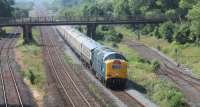
Margam Halt: A rare visitor to South Wales D9009 Alycidon passing Margam Halt with a Deltic Preservation trip from Burton on Trent to Shrewsbury.
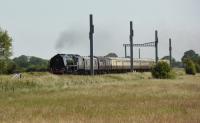
Shrivenham: LMS 46233 "Duchess of Sutherland", westbound at Shrivenham. This shows the state of the electrification pylons in the Swindon area. A major project to fully install the network will soon commence in Swindon.
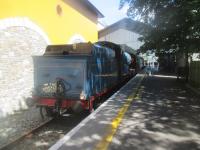
Killarney: GNR 4-4-0 No.85 'Merlin' at Killarney station, waiting to depart to Tralee with the Steam Dreams Emerald Isle Explorer, on 17th June 2017. An enquiry to the organisers of Steam Dreams revealed some spare seats to be available which we quickly purchased!
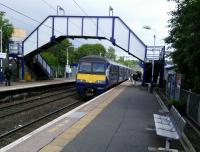
Anniesland: A 320 with a Dalmuir to Cumbernauld service calls at Anniesland on 17/06/2017.
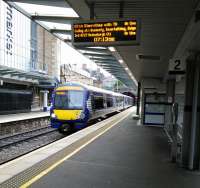
Haymarket: 170 453 pulls into Haymarket with a... well, you can see.

Killarney: Killarney station, with bus interchange station on the right, on 17th June 2017. This is is a dead-end terminus with the onward continuation of the line to Tralee starting from a junction just to the east of the station. Trains from Mallow to Tralee run in to the station and then reverse back to the junction before going forward while trains in the opposite direction run past the junction, set back into the station and then on re-starting continue to Mallow.
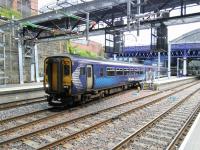
Glasgow Queen Street High Level: The 6-coach 0821 service for Oban and Mallaig leaves Queen Street on 17/06/2017. The announcements for these trains, complete with explanations of request stops, must be the longest on ScotRail.

Skyttorp: Open Day at the private Skyttorps Maskinmuseum 25km north of Uppsala in Central Sweden. The Museum specialises in preserving large construction machines on caterpillar tracks: cranes, draglines and diggers. In recent years a layout of 600mm Decauville track has been laid and industrial locos can be seen in action. Here a train rounds the sharp curve formed by the corner of a building and on towards the level crossing. To the left is the local Fire Station (a fire engine is barely visible through the foliage) with a static engine next to the track.
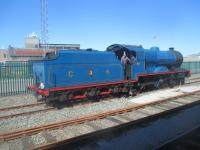
Tralee Casement: Having arrived at Tralee with the afternoon section of Day 6 of Steam Dreams' 'Emerald Isle Explorer' from Killarney, Great Northern Railway of Ireland broad gauge Beyer Peacock compound 4-4-0 No.85 'Merlin', dating from 1932, is now detached and ready to run round, on the gloriously warm and sunny evening of Saturday, 17th June 2017.
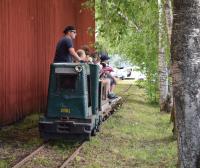
Skyttorp: The diesel hauled train reaches one end of the 600mm track layout at Skyttorps Maskinmuseum. This post-war Ruston DL 20 4wDM is generally only active on the day that the Museum has its Open Day in mid June.
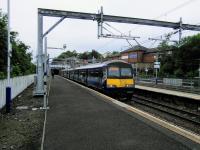
Springburn: The driver of 320 320 (so good they named it twice) has just changed ends to continue the journey from Cumbernauld to Dumbarton Central. Changing ends at Springburn was something diesels did in the past when there was no direct link between Queen Street High Level and Cumbernauld.
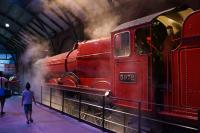
Leavesden Studios: GWR 4-6-0 5972 'Olton Hall' aka 'Hogwarts Castle' all 'steamed up' at the recreation of Kings Cross platform 9 and three quarters in the Warner Brothers studios at Leavesden, Watford.
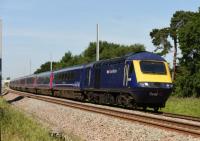
Shrivenham: HST 125 43 036 eastbound, passing the long gone station site at Shrivenham on the GWML.
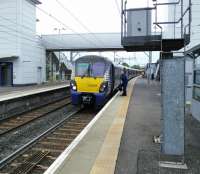
Airdrie: An Edinburgh to Milngavie service changes drivers at Airdrie on 17/06/2017.
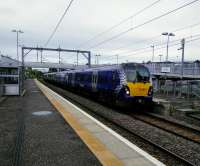
Drumgelloch: An Edinburgh-bound service calls at Drumgelloch on Saturday morning, 17/06/2017.
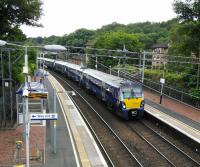
Hillfoot: A Milngavie to Edinburgh service makes its first stop, Hillfoot, on 17/06/2017.
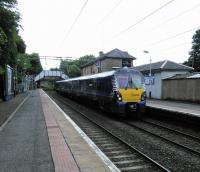
Bearsden: A Milngavie to Motherwell service calls at Bearsden on 17/06/2017.
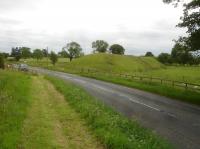
Newby Wiske: Shortly after leaving the East Coast main line at Cordio Junction the line to Leeds via Ripon and Harrogate crossed the A167 road south of North Otterington village before reaching the first station south at Newby Wiske. The view looking south shows a section of the lengthy stretch of embankment that runs south west from the former rail overbridge towards Newby Wiske. The approach from the north was mostly on the level or a shallow embankment, and the short built up section just before the bridge has been profiled down some 10m back from the road. Nothing remains of the bridge, where a vehicle can be seen parked where an abutment would have been.
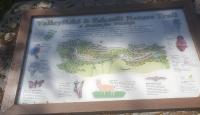
Eskbridge: I have drawn to Midlothian Council's attention the error that this was not the Peebles railway, on which I travelled many times. It's the Penicuik Railway! It was nice to catch the train from Eskbank.

Skyttorp: The Ruston meets the pre-war Orenstein & Koppel loco having a smokey startup and about to start shunting tippler mineral waggons. The Musuem area with a combination of traditional red-painted wooden and brick buildings retains its industrial flavour even if a few trees and some grass has grown up around the edges.
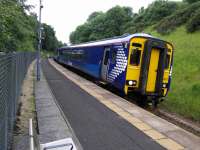
Kelvindale: 156432 rounds the curve into the Kelvindale platform with a Glasgow Queen Street service on 17/06/2017.
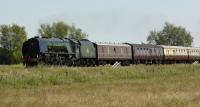
Shrivenham: LMS 46233 'Duchess of Sutherland', westbound at Shrivenham. Running one hour late due to a HST fire in Swindon station. The line from Didcot to Swindon was closed down for a while and the 4-6-2 sat in the Challow loops for an hour.
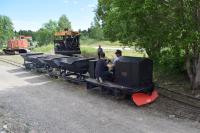
Skyttorp: The 1939 Orenstein & Koppel diesel (works no. 11429), complete with locally-added snowplough, in its working environment at the Skyttorps Maskinmuseum in Central Sweden. One of the diggers in the background is used to fill the wagons and the loco moves them to a place where the soil is tipped by hand.

Kelvindale: Kelvindale's connection with Van Gogh escapes me, but there is a fine selection of his works on display. I suspect though that they may be reproductions.
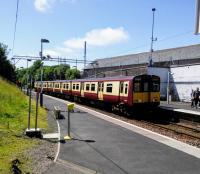
Neilston: Having arrived at Platform 2 (foreground) then reversed in the stub beyond the signal, a Glasgow bound Class 314 enters Platform 1 at Neilston on 17th June 2017.
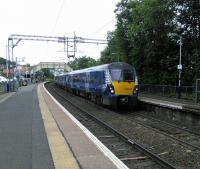
Westerton: Heralded by the whine and crump of the Westerton Junction points a Milngavie service calls on 17/06/2017.
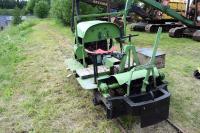
Skyttorp: This one seems to be a more home-spun type of machine than the others at Skyttorps Maskinmuseum in Central Sweden. It has a Volvo engine and gearbox possibly originating on a local peat railway. A few of the dozens of diggers etc. to be found at the Museum can be seen in this view. Many of these are Lincoln-built Rustons as well as more locally manufactured Ã…kerman machines. In the background is the big railway, Ostkustbanan, with Skyttorp Station a couple of hundred metres away to the right (north).
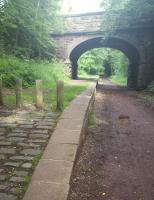
Rosslyn Castle: The former Rosslyn Castle station, now a footpath.
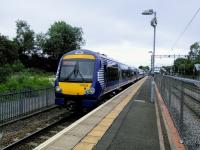
Anniesland: Unusually, this Maryhill line service at Anniesland is formed of a 170 with first class accommodation. Filling in for the usual fare, I expect.
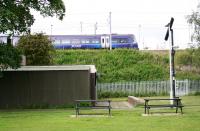
Newcraighall: Looking west across Newcraighall public park on 17 June 2018 , just as the 0845 ex-Tweedbank arrives at Newcraighall station on its way to Waverley.
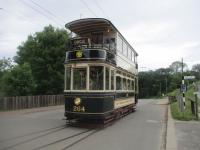
Beamish Open Air Museum: Sheffield Corporation No.264 at Beamish Open Air Museum on 17th June 2018. This was one of 24 sleek balcony cars delivered to Sheffield by the United Electric Car Company of Preston in 1907 and was rebuilt in 1926 with a fully enclosed upper deck. In 1938 it was renumbered 342 and relegated to peak hour only services, surviving until 1956. It was exhibited in the former London Transport Museum at Clapham until 1967 when it was removed to the premises of the Consett Iron Company. It arrived at Beamish in December 1973, re-converted to open top and worked in this form until 1985 when it was withdrawn for reconstruction back to its original Sheffield appearance, returning to service in 1987. It was further overhauled in 2014 but back in service for the 2016 season.
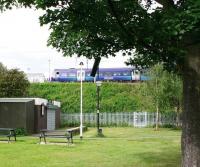
Newcraighall: The 0911 from Waverley arriving at Newcraighall station on 17 June 2018 on its way to Tweedbank.
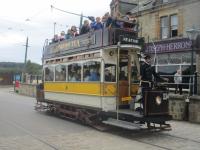
Beamish Open Air Museum: Newcastle Corporation No.114, restored to its original 1901 appearance and the oldest vehicle in Beamish Open Air Museum's tramcar fleet, seen here at The Town on the morning of 17th June 2018.
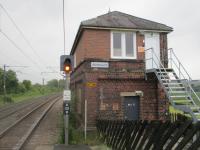
Alnmouth: Alnmouth signal box, at the north end of the up platform on the evening of 17th June 2018. The branch trains to the historic market town of Alnwick, withdrawn in September 1968, left from a bay platform on the far side of the down platform and went off through where fully-grown trees and bushes now stand in the left background. A short section of this is now the heritage Aln Valley Railway.
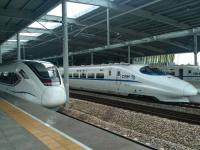
Jinshanwei: Contrasting front ends at Jinshanwei terminus of the Jinshan Railway from Shanghai South, essentially a commuter line but with much holiday traffic to the seaside resort as well. Perhaps the North Berwick branch might be a fair Scottish parallel! A new CRH6 outer-suburban unit has arrived non-stop from Shanghai South while an older CRH2 unit prepares to return to Shanghai South with a stopping service. 17th June 2018.
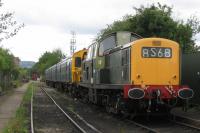
Chinnor: The last surviving Clayton Type 1 - D8568 - parked at Chinnor on 17th June 2018, together with BR 411/9 3-car CEP unit.

Chinnor: To the (slight) disappointment of the photographer - who had travelled specially to the Chinnor & Princes Risborough Railway to ride with the last surviving Clayton - the latter was substituted by 37 227 for the return trips to Princes Risborough. The Type 3 is seen here bringing the stock of the first train of 17th June 2018 into the Chinnor platform.
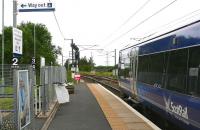
Newcraighall: A green light for the 0845 Tweedbank - Edinburgh, about to restart from Newcraighall station on 17 June 2018. The train will head north before making its penultimate stop at Brunstane. The signal 'feathers' are for the freight only route to Niddrie West Junction.

Beamish Open Air Museum: Newcastle Corporation tramcar No.114 at Beamish Open Air Museum, County Durham, on 17th June 2018. This is the sole survivor of 24 A Class trams built at Hurst Nelson & Co. Ltd. of Motherwell in 1901 and many changes were made to it during the time it ran in Newcastle, including the addition of a roof for upper deck passengers. It was sold to Sheffield Corporation in 1941, becoming their No.317 and ran for a further 10 years until 1951. Discovered rotting away on a farm at Scunthorpe in Lincolnshire, it was moved to Beamish in 1987 for restoration, which took nine years to complete. It has been fully restored to its 1901 Newcastle Corporation appearance, minus an upper deck roof, and first carried passengers at Beamish in May 1996. It is the oldest vehicle in the museum's tramcar fleet.
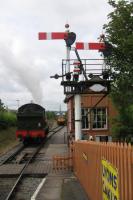
Chinnor: Semaphore signals, steam and a classic DMU at Chinnor on 17th June 2018.
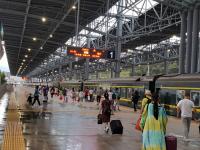
Dali: Train K9635, the 19.55 from Dali to Lijiang awaits passengers at platform 1 of Dali station on 17th June 2018. Each of the day time trains to Lijiang consists of 18 coaches, all sleeping cars in use for day time travel. There are 22 compartments in each car with a capacity of 8 people seated each so each train can move over 3000 people and this one certainly appeared to be full. Despite the challenge of boarding 3000+ people in 15 minutes the train left on schedule and arrived in Lijiang early. A trolley service is also provided.
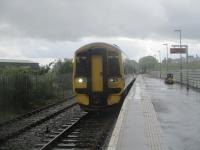
Thurso: 158717 from Inverness arriving in pouring rain at Thurso station at 14.21 on 17th June 2019. The train waited here for only six minutes before departing back to Georgemas Junction and continuing on to Wick. Since the abandonment of splitting trains at Georgemas into Thurso and Wick portions, running a single service up to Thurso first before reversing for Wick has, at least, given a direct rail service between the two main towns of Caithness, even if it does take longer now for Wick passengers to reach their destination.
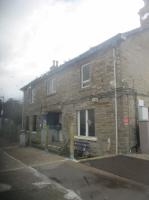
Georgemas Junction: Georgemas Junction station building, the UK's most northerly junction, where the Wick and Thurso lines divide, seen in heavy rain from 158717 returning from Thurso before continuing to Wick, on 17th June 2019. This train will have reversed at this station only half an hour or so earlier to go up to Thurso, reversing again there and thus serving Georgemas twice in the now even longer journey from Inverness to Wick.
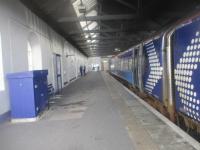
Wick: Unlike at Thurso, trains still pull up beneath the train shed at Wick station where 158717 rests after its long journey from Inverness (via Thurso) at 14.56 on 17th June 2019. It returned to Inverness at 16.00 (again via Thurso) which gave us just an hour for a quick look round Wick (which I had not been to since 1990) and find a cafe for afternoon tea before returning south to our b & b for the night at Alness.
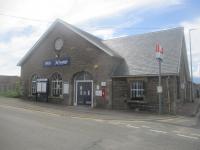
Wick: Wick station opened 145 years ago on 28th July 1874 and was almost Beechinged, along with Thurso and the entire line back to Inverness, as well as the Dingwall to Kyle of Lochalsh line but was thankfully reprieved. Alas, the same cannot be said for the lines to the Moray Coast and Fraserburgh and Peterhead, the latter two towns now many miles from the nearest railway tracks. Had sense prevailed, they could still be enjoying a rail service as Wick and Thurso do but, despite vociferous protests, it was to no avail. This view of the exterior of Wick station is on 17th June 2019.
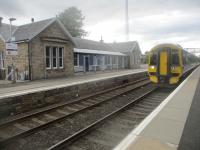
Tain: 158717 with the ex-16.00 service from Wick via Thurso to Inverness calling at Tain station on 17th June 2019. My friend Paul and I were bound to our one night's b & b at Alness and this train did not stop there so we had to change here at Tain and await a stopping train to Inverness which started from the next station north at Ardgay.

Glasgow Queen Street High Level: HST powercar 43030 and Hitachi EMU 385023 seen at Glasgow Queen Street on 17th June 2019, a fortnight before platforms 2 and 3 were due to close to allow work on the platform 2 and 3 extensions in order to accommodate 8 coach trains.
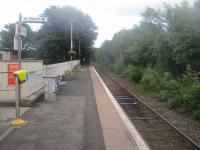
Alness: The single platform Alness station, on the Far North of Scotland line, looking north on the evening of 17th June 2019. This was one of several stations on the line that closed on 13th June 1960 (along with the branch from The Mound to Dornoch), an attempt at closure by stealth of the entire line although Rogart, also closed at that time, reopened very quickly on 6th March 1961. After the line was saved (and quite rightly, too) several other closed stations were later reopened and Alness came back from the dead on 7th May 1973. It is just a basic platform with, inevitably, a ubiquitous bus stop style waiting shelter but better that than no station at all for this very pleasant Highlands town.
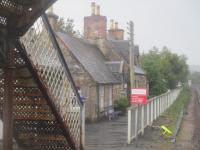
Lairg: Lairg station building, now a private residence, seen from 158717 calling at the shortened southbound platform with the ex-16.00 service from Wick via Thurso to Inverness, on 17th June 2019.
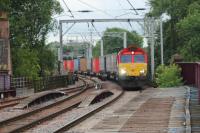
Coatbridge Central: DB 66128 brings the Daventry to Grangemouth Intermodal through Coatbridge Central on 17th June 2019.

The Mound: Substantial remains of the former The Mound station, one-time junction for the branch to Dornoch, being passed by 158720 from Inverness to Wick via Thurso, on the morning of Monday, 17th June 2019. Both the Dornoch branch and The Mound closed on 13th June 1960. The old station at Dornoch also survives to this day and which I visited way back in June 1990. See image [[69579]].
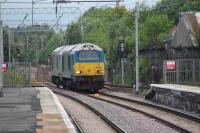
Coatbridge Central: Unusual visitors to Coatbridge. 67001 and sister loco 67012 passing through Coatbridge Central on route to Mossend from Bo'ness on 17th June 2019. Two days earlier they had hauled the SRPS excursion from Glenrothes to Llandudno See image [[69206]].
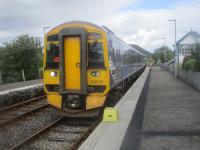
Rogart: The first train of the day from Inverness to Wick via Thurso, in the hands of 158720, arriving at Rogart station, dead on time at 09.06 on 17th June 2019. I'm used to hailing buses in London but this was the first time I'd ever hailed a train, Rogart being a request stop. We then went to Thurso for lunch before going on to Wick for afternoon tea and back to Alness for an overnight stop in an excellent b & b. Note too the mounting block to assist passengers to and from the very low platform.
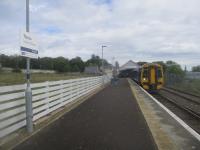
Thurso: Having reversed at Georgemas Junction, 158 720 from Inverness has just arrived at Thurso station at 10.58 on Monday, 17th June 2019. The most northerly station on the UK mainland and saved from being closed under Beeching along with the lines to Wick and Kyle of Lochalsh from Inverness in 1965. The train waited here for a few minutes before returning back down the branch and on to Wick, thus serving Georgemas Junction twice.

Thurso: 158720 just arrived at Thurso station from Inverness at 10.58 (this photo was taken three minutes later) on 17th June 2019. Trains no longer pull up under the train shed - but they still do so at Wick.
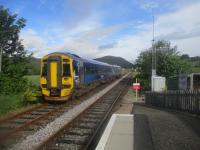
Rogart: 158707, with the first train of the day from Wick via Thurso to Inverness, departing from the request stop at Rogart, early on the morning of Monday, 17th June 2019. People are supposed to loathe Monday mornings but this was one I didn't mind in the slightest!
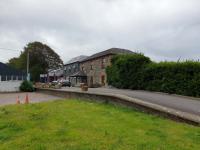
Clonakilty: Clonakilty Station, now a private residence, from the former buffer stops. The branch from Clonakilty Junction opened in 1886 and closed with the rest of the former CB&SCR system on 31st March 1961.

Clonakilty Junction: Clonakilty Junction, and the steps which led down to the platforms from the original N71 road, with the former station master's house on the right. The new N71 road beyond now occupies the trackbed. 17th June 2020.

Bandon: Bandon High Level Station looking east towards Cork on 17th June 2020. The CB&SCR reached Bandon in 1849 and originally terminated at a low level station. With the subsequent extensions westwards to the line, a new high level station was opened in 1894. It survives today as County Council offices although the course of the line through the town on embankments and bridges has largely been obliterated with just a handful of bridge abutments surviving. The station closed, with the rest of the system, on 31st March 1961 although track lifting operations continued for several years afterwards.
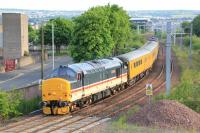
Grangemouth: 37419, looking resplendent in Inter-City livery, heads the Network Rail test train at Grangemouth on 17th June 2020. 37423 was on the rear.

Clonakilty Junction: Clonakilty Junction. Original and now rather dilipidated nameboard with the former station master's house to the right. The station is located in the village of Gaggin (also spelled Gaggan). There were three platforms, including an island platform. The nine mile branch to Clonakilty diverged south from the main line here, opening in 1886. A further branch to Courtmacsherry diverged from the Clonakilty branch at Ballinascarthy (birthplace of Henry Ford's father). The system closed on 31st March 1961 and the N71 road was subsequently re-aligned here along the former trackbed.
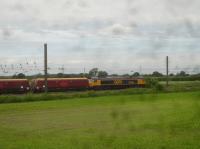
Raskelf: GBRf 66785 is seen running north, just after the site of Raskelf station, on 17 June 2021. It is hauling a rake of twenty two former EWS HHA bogie coal wagons on the 07.54 4Z65 special working from March to Tees Yard.
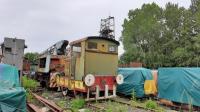
Astley Green Colliery: On 17 June 2021 this small Ruston diesel (No 244850 of 1946) is seen in the company of a number of narrow gauge mining locomotives and other standard gauge artefacts at the Lancashire Mining Museum at Astley Green Colliery. A 2ft gauge railway has recently opened on the site to add to the main attraction which is a Yates and Thom steam winding engine. The locomotive is not far from its previous homes, having previously operated at Rosebridge and Ince Hall Wagon Works and then Wm Park & Co (Forgemasters) at Ince Forge, near Wigan.
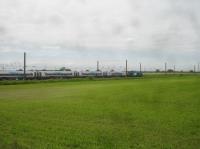
Raskelf: DRS 68033 leads a Transpennine Express Nova 3 push-pull coaching set on the 11.43 Milford Loop - Saltburn ECS working on 17 June 2021. This working nearly caught me out, only noting its rapid approach after hearing the roar of the loco engine, as these sets normally work no further north than York. Since taking this view TPE have indicated that they are considering using them on some workings through Middlesbrough, to Saltburn if they gain approval to extend beyond Redcar Central, due to loco noise complaints in Scarborough during overnight stabling. I believe they have also had noise complaints at Redcar from the class 185 DMU, for the first morning departure, standing idling for a long time after arrival from Siemens depot at York; and have had to delay its arrival.
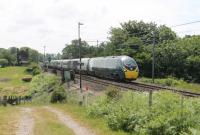
Bay Horse: On the ultimately unsuccessful attempt to break the Euston to Glasgow speed record, 390044 'Royal Scot' hurries through Bay Horse on 17th June 2021. This charity fund raising event was a joint event between Avanti, Network Rail and Railway Magazine and created lots of national media interest but the Pendolino was twenty one seconds slower than the prototype APT in 1984.
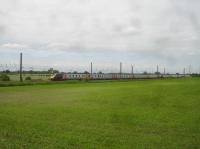
Raskelf: Cross Country 9-coach 221/220 combination, formed of 221127+220032, heading south near Raskelf with the long distance 1V58 11.39 Newcastle to Penzance working on 17th June 2021.
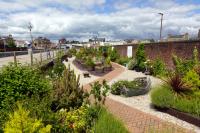
Largs: Largs Community Garden looking north in June 2021. Sometime Platform 2 on the left, with the high wall built on the edge of Platform 1 so the platform is behind and now a walkway to Morrison's. The bush to the right is about where the Jumbo station pilot used to sit on Fair Holidays. Attractive as the scene is now, I'd prefer the Jumbo any day.
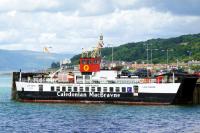
Largs Pier: There are suggestions that Calmac will retire some of the fleet and replace them with new tonnage. One on the list is 'Loch Riddon', which was new on the Cumbrae route in 1986 with sister 'Loch Striven', replacing 'Isle of Cumbrae', the first drive-through. 'Loch Riddon' was moored alongside Largs Pier on 17th June 2021. 'Loch Shira' was the service vessel this day.

Uffington: 59204, eastbound at Longcot on the GWML near Uffington, on 17th June 2021, which was not the brightest of days. The consist is made up of a fully loaded stone train from Whatley Quarry to Oxford Banbury Road. Reporting number 663S.
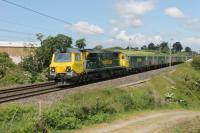
Bay Horse: Standing in for the more usual Class 66/6, 70017 works the Hardendale to Tunstead box wagons south through Bay Horse on 17th June 2021.
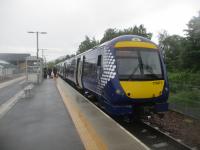
Tweedbank: 170471, just arrived at the Borders Line terminus at Tweedbank with the ex-11.11 service from Edinburgh Waverley, exactly one hour later on Friday, 17th June 2022. The morning's heavy rain was starting to abate by this time.
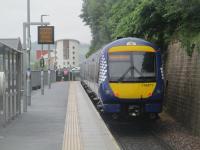
Galashiels: 170471 departing from Galashiels with the ex-12.19 Borders Line service from Tweedbank to Edinburgh Waverley, at 12.23 on Friday, 17th June 2022.
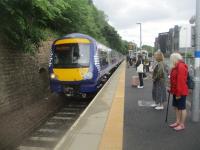
Galashiels: 170434, with 170415, arriving to a reasonable-sized crowd of waiting passengers at its first port-of-call at Galashiels with the 13.23 (ex-13.19 from Tweedbank) Borders Line service to Edinburgh Waverley, on Friday, 17th June 2022. At the south end of this station, on the right in the distance across the intervening road, is the bus station labelled as Galashiels Interchange and offering onward transportation to now railway-less towns like Peebles, Selkirk, Melrose and Hawick. However, there is no direct interchange between this and the rail station, passengers having to cross the road on the level to get from one to the other.
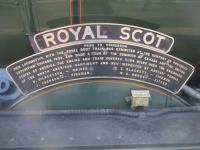
Edinburgh Waverley: Supplementary commemorative plate carried by 46100 'Royal Scot', pictured at Edinburgh Waverley on 17th June 2022, waiting to depart at 18.16 with Steam Dreams circular railtour via the Forth Bridge and Dunfermline Town and back via the freight line to Alloa, then Stirling and Linlithgow.
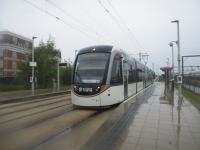
Balgreen [Tram]: Edinburgh Trams no. 266 to Airport calling at Balgreen stop, in pouring rain at 10.34 on Friday, 17th June 2022.
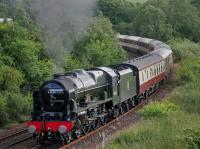
Inverkeithing East Junction: 46100 *Royal Scot* nears Inverkeithing East Junction with the Steam Dreams 'Forth Circle' excursion on 17 June.
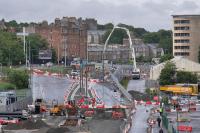
Newhaven [Tram]: Work continuing in June 2022 to link the Newhaven terminus with Ocean Terminal.
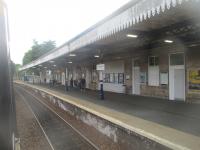
Dunfermline Town: The main building of Dunfermline Town station, seen from departing Steam Dreams' circular railtour from Edinburgh Waverley behind 46100 'Royal Scot', after the locomotive had quenched its thirst, at 19.52 on Friday, 17th June 2022. From here, the train took the freight-only line to Alloa, closed to passengers in 1930 and which was a lot more picturesque than I had expected it to be, notwithstanding the eyesore of the derelict Longannet Power Station.
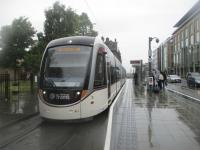
St Andrew Square [Tram]: Edinburgh Trams no. 266 just arrived from Airport at the temporary city centre terminus at St Andrew Square, in pouring rain at 10.09 on Friday, 17th June 2022. The old terminus at York Place has been abolished, pending completion of the Newhaven extension when a replacement stop across the road at Picardy Place will open. Trams, however, still have to run, empty, down to York Place to reverse and return to the opposite platform before they can take up their next service to Airport.
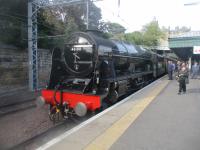
Edinburgh Waverley: 46100 'Royal Scot' at the head of Steam Dreams' circular evening railtour via the Forth Bridge, Dunfermline Town, Alloa and Stirling, at Edinburgh Waverley at 18.04 on Friday, 17th June 2022. The train departed on time at 18.16.
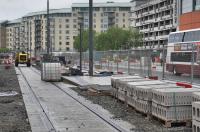
Ocean Terminal [Tram]: Ocean Terminal stop, with electrification poles starting to appear, on 17 June 2022.
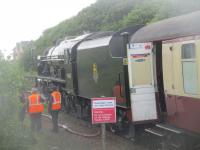
Dunfermline Town: 46100 'Royal Scot' taking on water at Dunfermline Town, during Steam Dreams' evening circular tour from and back to Edinburgh Waverley, at 19.43 on Friday, 17th June 2022. As well as quenching the locomotive's thirst, this enabled passengers to enjoy a 20 minutes leg stretch.
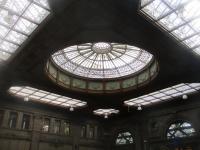
Edinburgh Waverley: The magnificent roof of the spacious waiting room at Edinburgh Waverley, at 17.30 on Friday, 17th June 2022. Taken while my friend Paul and I were enjoying a drink while waiting for Steam Dreams' circular evening railtour behind 46100 'Royal Scot' across the Forth Bridge and around Fife via Dunfermline Town and return via Alloa and Stirling and which left on time at 18.16 (see my photo no. 81342).
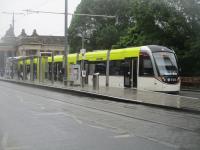
Princes Street [Tram]: Edinburgh Trams no. 262 from St. Andrew Square to Airport calling at Princes Street stop, in pouring rain at 09.36 on Friday, 17th June 2022. St. Andrew Square is currently being used as a temporary terminus during the construction of the Newhaven extension which has seen the original 2014 terminus at York Place abolished.
Events
Events from the chronology which occured on this day. This generally lists events before 1995, the creation of the website.
| Year | Companies | Description |
|---|---|---|
| 1850 | North Berwick Branch (North British Railway) | Line opened completely to North Berwick, Williamstown_>North Berwick Williamstown closed. |
| 1853 | Leven Railway | Authorised from Thornton Junction to 1st_>Leven 1st . |
| 1901 | Hill_of_Howth_Line_(Great_Northern_Railway_[Ireland>Hill_of_Howth_Line_(Great_Northern_Railway_[Ireland>Ireland>Hill_of_Howth_Line_(Great_Northern_Railway_[Ireland>Hill of Howth Line (Great Northern Railway [Ireland) | Sutton to Summit opened. Power station at depot at Sutton. |
| 1957 | Lanarkshire and Ayrshire Railway | Kirkhill (Kirkhill Junction) to Carmyle (Westburn Junction) closed to passengers. |
| 1963 | Wilsontown, Morningside and Coltness Railway | Shotts East to Westcraigs Junction closed. |
| 1984 | Dingwall and Skye Railway | Strathcarron east box closed, Strathcarron west box converted into gate box. |
| 2002 | Caledonian Railway | Southbound Mossend to Warrington timber train derails at north end of Quintinshill Loops. |
News
These are old news items which which occured on this day. This generally lists events after 1995, the creation of the website.
| Year | Companies | Description |
|---|---|---|
| 2002 | Jacobite Steam Train season starts | The Fort William to Mallaig steam hauled passenger train commences running. |
| 2002 | Derailment at Quintinshill | A timber train derailed at Quintinshill blocking the line in both directions. Replacement buses for passenger services which were not able to run were organised. |
| 2002 | North Berwick^s 150th anniversary | North Berwick 150th anniversary first public run of a Class 318, working the 1137 ex-Waverley and 1220 return on Saturday 17 June. |
| 2004 | Path lights to turn drivers on to train travel [Scotsman] | A SECLUDED footpath is being fully lit under a £90,000 upgrade. |
| 2008 | Leader calls for rail link unity [BBC News Article] | Fife Council^s leader says politically bickering is threatening the proposed Levenmouth rail link. |
| 2008 | Bonjour...c^est Gare de Haymarket.. | A French announcer at Edinburgh^s Haymarket Station is proving to be a hit with female commuters. |
| 2009 | End of the line for Central Station loitering [Network Rail Article] | Network Rail, supported by the British Transport Police, is launching a crackdown on anti-social behaviour and loitering at Glasgow Central. |
| 2010 | Network Rail boss Iain Coucher to step down [BBC News] | The chief executive of Network Rail, Iain Coucher, is to resign after eight years with the firm. |
| 2010 | The future of rail franchising [Department for Transport] | The Department for Transport will shortly begin a consultation exercise on the future of rail franchising policy. [From Mark Bartlett] |
| 2011 | Borders Rail Link in doubt as bidder No 2 walks away [Scotsman] | MINISTERS are to review the future of the troubled Borders Railway project after one of the two remaining bidders signalled it would abandon the race for the £230 million contract. The IMCD consortium^s move came after The Scotsman revealed yesterday that a key partner in the group had quit. |
| 2011 | Is it time to re-privatise East Coast rail? [Guardian] | It is now almost two years since the announcement that the embattled National Express franchise running along the east coast mainline was to be formally renationalised, establishing a new operator, East Coast Rail, connecting much of the North East and Yorkshire with both London and Scotland |
| 2012 | Siemens^ £1.4bn Thameslink trains contract close to being signed [Guardian] | Siemens expects to finalise the £1.4bn Thameslink trains contract this summer, amid renewed calls to halt the process and award the deal to the Bombardier plant in Derby. On the first anniversary of the controversial decision to give a large procurement contract to a German manufacturer, Siemens said the agreement is close to being signed. The trains will be built at the company^s Krefeld plant near Düsseldorf, which has led to calls by trade unions for government-backed manufacturing contracts togo to British businesses in the future. |
| 2013 | Edinburgh-Glasgow rail faces train upgrade delay [Scotsman] | COMMUTERS on Scotland’s flagship rail line will have to wait two years longer than expected for more seats, The Scotsman has learned. The latest blow to passengers on the main Edinburgh-Glasgow route comes days after it emerged that promised cuts in journey times would also not happen until 2018. Opposition parties united to condemn the further setback to the Edinburgh-Glasgow Improvement Programme (Egip), which was slimmed down by one-third to £650 million last July to save money. |
| 2013 | Edinburgh to Glasgow rail delays after cow struck by train on line [STV] | A cow has been struck by a train on the Edinburgh to Glasgow rail line. The incident caused disruption to services after the animal was hit by the train to the west of Lenzie Train Station in East Dunbartonshire. |
| 2014 | Mock tram seeks home - What would you do with it? [Evening News] | IT’s been a £776 million roller-coaster that left an entire city scratching its head wondering how it ever went so wrong. But, true to form, those pesky trams are at it again and posing a fresh conundrum: what do you to do with a motor-less and wheel-less streetcar? [From Richard Buckby] |
| 2014 | Bid to re-open Portobello railway station [Evening News] | CAMPAIGNERS are pushing to re-open Portobello Railway station to the public 50 years after a decision was made to close it. The station has not been in use since 1964, but would be reopened under ambitious proposals being put forward by Portobello Community Council. Engineering issues and cost had previously derailed bids to revive the station, but it is understood the Borders Railway project will soon resolve one of the main obstacles. |
| 2015 | Train carriage from 1882 at heart of Cornish bungalow [BBC News] | A bungalow constructed around a refurbished 19th Century railway carriage is going on the market. The First Great Western carriage was placed on a site near Helston in Cornwall in 1930 by Elizabeth Richards, who lived there until she died in 1966. Master carpenter Charles Allen restored the carriage, from 1882, and built a bungalow around it with help from his son-in-law Jim Higgins. The estate agent in charge of the sale said the construction was ^unique^. [From Mark Bartlett] |
| 2015 | Rail firm ‘breaks promise’ on reviving village station [Edinburgh Evening News] | Rail bosses have told campaigners they can’t keep a promise to reopen a mothballed East Lothian station next year – because there aren’t enough trains in Scotland. Campaigners say they are “very concerned” after being told by ScotRail that the planned reopening of East Linton station will be delayed by up to two years. |
| 2016 | Train derails at Paddington: Services disrupted in and out of station [BBC News] | Passengers travelling through London Paddington are facing continued disruption after a train derailment. Network Rail said the empty train had passed a red signal outside the station, activating an automatic derailment on Thursday. Overhead power lines also came down. Operator GWR expects to run only half its normal service on Friday morning. Network Rail said a limited service would run to and from London Paddington until the end of Friday. |
| 2017 | Campaigners renew push for St Andrews rail link [Scotsman] | Campaigners have launched a new push to restore St Andrews to the rail network - but acknowledge there are many hurdles to clear in their long-running quest. They have published a report highlighting the benefits of re-opening the five-mile line to the Fife town, which closed nearly 50 years ago. However, the St Andrews Rail Link campaign (StARLink), which was founded in 1989, is still waiting for a bid to be lodged to fund the detailed study required before ministers would consider such a scheme. Research commissioned five years ago showed the line would cost up to £71 million but cover its operating costs and provide faster journeys from Edinburgh than by road. |
| 2017 | ScotRail staff to wear body cameras in national roll-out [Courier] | ScotRail is looking at deploying 230 body cameras for its frontline workers to protect them from physical and verbal attacks. It follows a proposed national roll-out of the cameras by Police Scotland. Privacy campaigners have warned that public bodies are increasingly using intrusive surveillance when the case for doing so has not been made. The rail operator is seeking bidders to supply and maintain the cameras and the monitoring system over three years following a trial in 2015. That trial was held in response to a rise in assaults on staff, which rail bosses say are an ongoing problem. |
| 2018 | Calls to tackle Edinburgh Bypass gridlock as tram system to Musselburgh mooted [East Lothian Courier] | Musselburgh^S MSP has backed calls for improvements to the Edinburgh City Bypass while suggesting extending a tram or light rail system to the Honest Toun. |
| 2019 | Electrification hope encourages Borders Railway extension ambition [BBC News] | The electrification of the Borders Railway would make the viability of extending the route to Carlisle ^far better^, according to campaigners. The Scottish government has confirmed it is considering the move on a number of routes around the country. It would help to cut journey times and improve reliability on the line. The Campaign for Borders Rail (CBR) said it believed it would also strengthen its case for taking the line past its current terminus at Tweedbank. |
| 2020 | De-icing platforms get share of £9.4m fund to revolutionise railways [ITV News] | The technology is due to be trialled at a UK station within the next nine months. |
| 2020 | Face coverings to be made compulsory on Scottish public transport [Scotsman] | Passengers on buses and trains will have to wear coverings to help reassure fellow travellers, The Scotsman has learned. |
| 2020 | Covid-19 Update - The Jacobite [West Coast Railways] | We received some positive news yesterday. It was announced by the Scottish Government that they intend to lift the restrictions on the tourism and the leisure sector on Wednesday 15th July, and this would be confirmed on Thursday 9th July. We are therefore gearing up and preparing the Jacobite to take to the rails once more, passengers travelling can be assured that all relevant safety precautions will be met and further details will be sent to travellers well in advance. Visit The Safe Way, to find out how we^re preparing. |
| 2020 | Range of historical discoveries made in tram project excavations [Edinburgh Trams] | Whale bones, a cannonball and historic human remains were amongst finds. Archaeologists also found potential evidence of the area^s 16th and 17th century fortifications. The team are now resuming their work to explore Leith^s heritage as the project recommences. |
